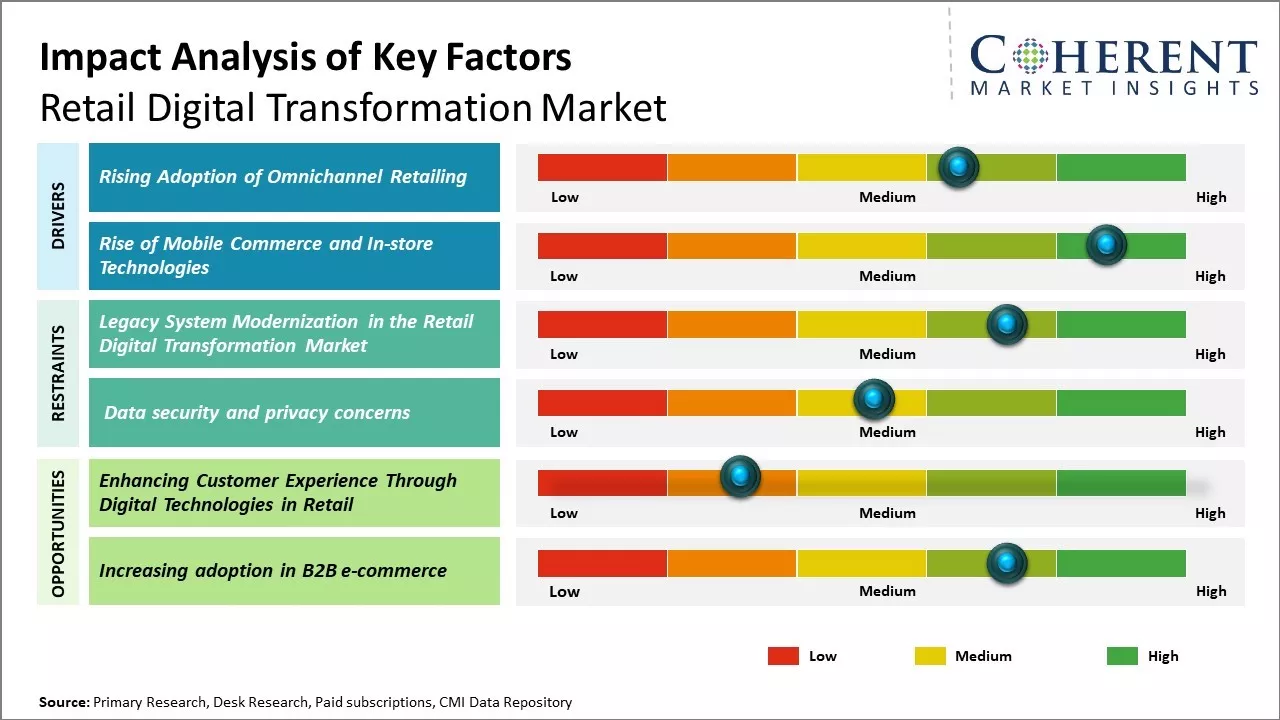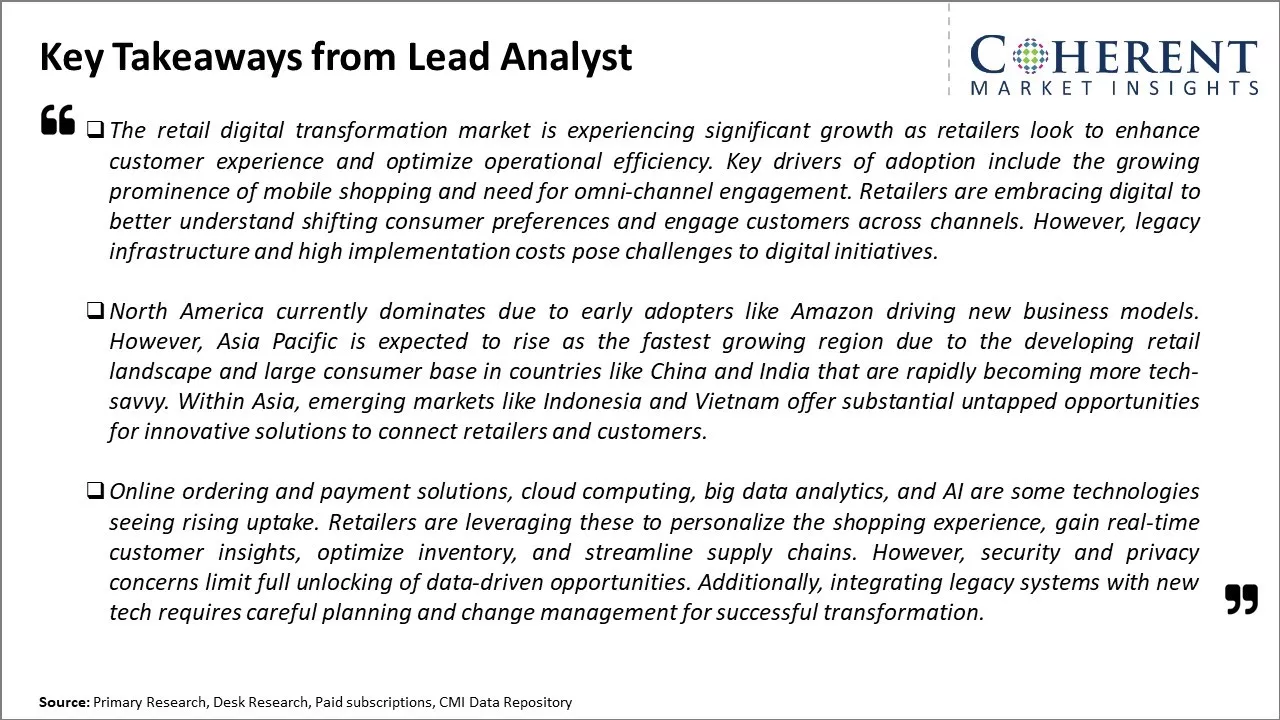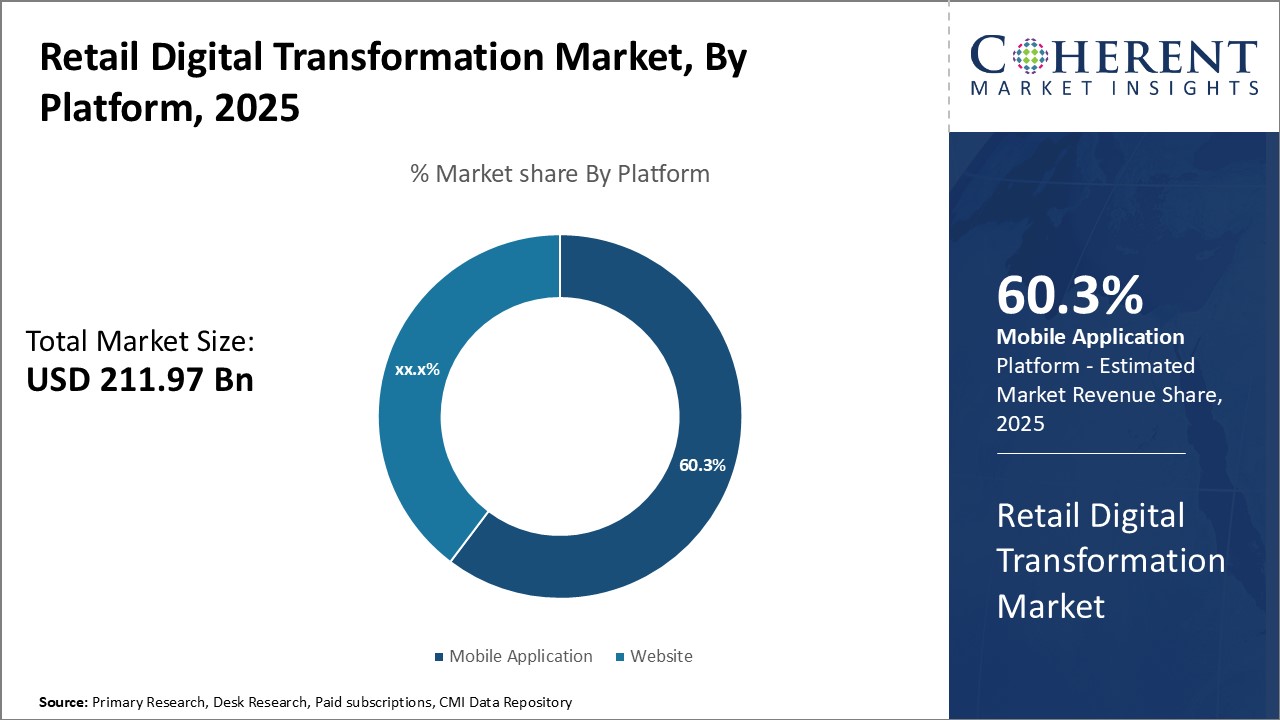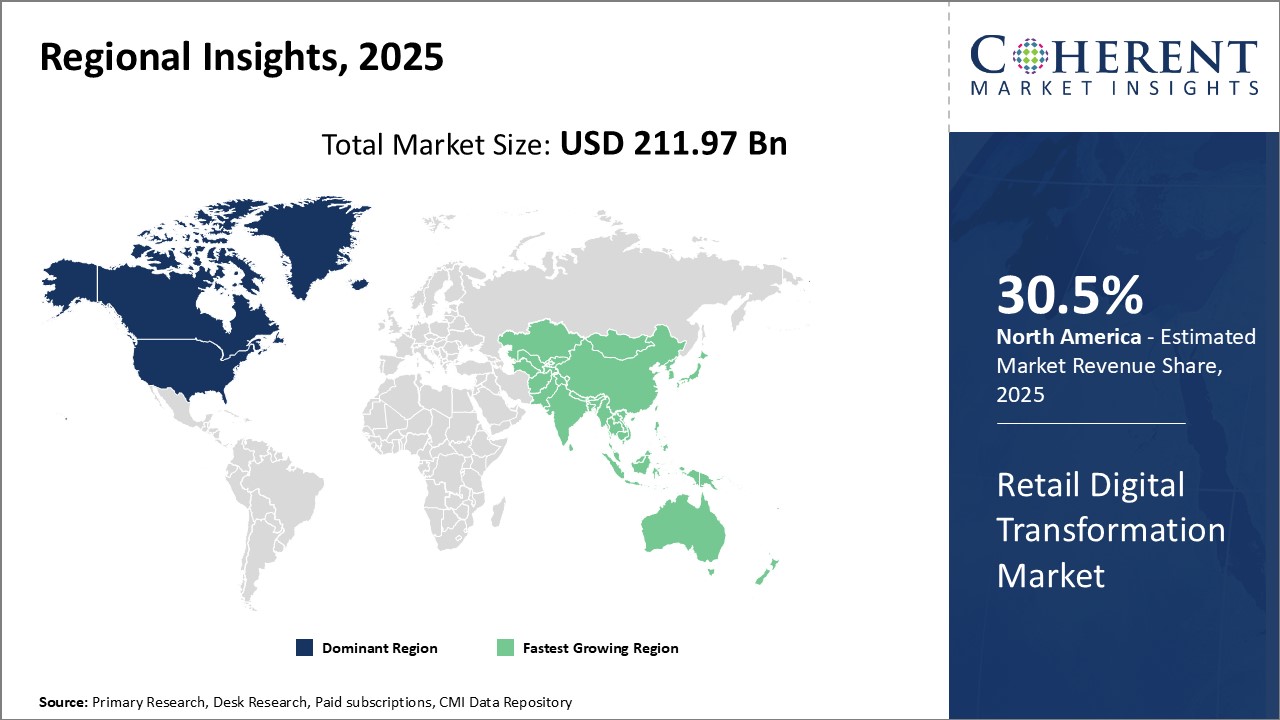The Retail Digital Transformation Market is estimated to be valued at US$ 211.97 Bn in 2025 and is expected to reach US$ 659.75 Bn by 2032, growing at a compound annual growth rate (CAGR) of 17.6% from 2025 to 2032. The growing adoption of advanced technologies such as AI, ML, augmented reality, and cloud computing across the retail industry is expected to significantly drive the market during the forecast period.

Discover market dynamics shaping the industry: Download Free Sample
The retail digital transformation market is witnessing significant changes in trends. Omnichannel experience is becoming critical for retailers as consumers research online but wish to purchase offline. Personalization is key and retailers are leveraging technologies to gain better customer insights. With rising adoption of mobile wallets and payments, retailers are focusing on enhancing mobile point-of-sale capabilities. Advancements in computer vision and AI are also enabling applications like virtual shopping assistant bots.

Get actionable strategies to beat competition: Download Free Sample
Rising Adoption of Omnichannel Retailing
With the advancement of technologies, customers are no longer limited to traditional brick-and-mortar stores for shopping. They now expect a seamless omnichannel experience regardless of which channel they use. Customers want to be able to research products online, check real-time availability and pricing, place orders online for in-store pickup or delivery, return online purchases at physical stores, and so on. As a result, retailers are investing heavily in integrating their online and offline channels to provide a unified shopping experience to customers.
Enabling omnichannel retailing requires significant digital transformation across the retail organization. Retailers need to overhaul their supply chain and inventory management systems to facilitate activities such as buy online pickup in-store. They also need to modernize their point-of-sale systems to allow associates to efficiently manage buy online return in-store transactions. Most importantly, retailers are focusing on developing a strong omni-commerce strategy and building consistent brand experiences over different channels. They are leveraging technologies like AI and predictive analytics to gain better customer insights and create personalized recommendations and engagement. All these initiatives require heavy investments in areas like cloud computing, mobility solutions, and data analytics tools. Therefore, the growing need amongst retailers as well as customers to enjoy a truly omnichannel shopping experience has become a major force driving digital transformation initiatives across the retail sector.
Rise of Mobile Commerce and In-store Technologies
Another key trend fuelling digital initiatives has been the exponential growth of mobile commerce. According to surveys, over 80% of customers now use their smartphones to research products while shopping in physical stores. They scan product barcodes for reviews and pricing checks, or click on promotional QR codes for more information. Customers have also come to expect in-store access to the entire catalog, easy payment options, and engagement through digital concierge services. As a result, retailers are extensively employing mobile point-of-sale solutions, digital signage, interactive kiosks, augmented/virtual reality trials, beacons, and inventory management devices driven by Internet of Things technologies.
In order to deliver on these rising customer expectations of an enriched in-store experience, retailers need to implement innovative mobile and digital in-store technologies. This requires modernizing their infrastructure with investments in areas like cloud computing, digital asset management systems, mobility platforms, and location services.

To learn more about this report, Download Free Sample
Market Challenges: Legacy System Modernization in the Retail Digital Transformation Market
The retail digital transformation market faces the challenge of getting outdated legacy systems modernized. Many retailers still rely on old and inefficient software and database systems that make integrating new technologies difficult. Transforming these platforms and integrating them with newer solutions requires time, capital investments and expertise that not all retailers have readily available.
Market Opportunities:
As consumer shopping habits continue shifting online, there are major opportunities for retailers to utilize digital technologies to improve the customer experience. Implementing technologies like AI, analytics, cloud computing, mobile apps and augmented reality give retailers ways to engage customers virtually, gain real-time insights into purchasing behaviors and enable convenient services like curbside pickup. These tools can help transform brick-and-mortar stores into seamless omnichannel experiences.

Discover high revenue pocket segments and roadmap to it: Download Free Sample
Among the various product segments, consumer electronics contributes the highest share to the retail digital transformation market. Advanced electronics like smartphones, tablets, laptops, and smart devices have become essential enablers of the connected commerce experience. Customers use these mobile devices to research products online, read reviews from others, compare prices across retailers, and complete transactions from any location at their convenience.
With powerful yet affordable devices, consumers are harnessing digital technologies like never before for their shopping needs. Retailers are correspondingly improving their in-app and mobile web experiences to optimally serve these always-connected shoppers and attract them to newer categories as well. Convenient payment options through NFC, digital wallets and QR codes have further boosted mobile purchases of electronics and other products.
As versatile smartphones replace purpose-built devices, they have become the universal remote for purchasing, especially among young shoppers who research and buy fashion, accessories, electronics and more on these pocket computers. Fast delivery and easy returns are also driving higher consumer electronics sales on digital platforms. Retailers are catering to this vibrant audience by conceptualizing hyper-personalized experiences around aspirational electronic devices and gadgets.
In summary, the ubiquity of powerful yet affordable consumer electronic devices has majorly transformed shopping behaviors, established new trends and empowered retailers with tools to effectively engage digitally savvy audiences for driving growth across categories. This underpins why consumer electronics dominate the retail digital transformation landscape in terms of products.
Insights By, Platform- Mobile Applications Empower Consumers to Shop from Anywhere
In terms of platform, mobile applications contribute the highest share of the retail digital transformation market owing to ever-increasing smartphone penetration and on-the-go shopping habits of consumers. Mobile apps allow retailers to engage customers anywhere and at any time, giving them a truly omnichannel experience. Customers can browse stores, check prices and product details, read reviews, add items to wish lists or carts, and even complete purchases directly from their phones.
This high level of convenience has made mobile the primary shopping channel for many. Apps provide personalized, location-based recommendations and promotions to better target consumers based on past purchases and browsing history. Interactive features like chatbots, augmented reality try-ons, and social sharing also enhance the mobile shopping experience. For time-strapped customers, apps streamline the shopping process and allow them to buy what they need quickly from anywhere.
Additionally, mobile payment options through digital wallets provide a seamless checkout without the need to enter billing or shipping details again on small screens. This further boosts the share of purchases made on-the-go. Retailers are recognizing the shift to mobile-first customers and investing heavily in optimizing their apps for superior usability, speed, personalization and payment integrations. Branded apps allow building direct relationships with shoppers as well as collecting valuable customer data and insights.
As better app experiences encourage more frequent mobile browsing and in-app engagement, retailers are able to promote additional high-margin products, services and loyalty programs to their digitally connected customers. Over time, the dominance of mobile apps in powering the new digital-led shopping is expected to grow further.

Need a Different Region or Segment? Download Free Sample
The North American retail digital transformation market is currently the largest globally, dominating over 30.5% of the total market share. The United States accounts for the bulk of investment and activity in the region, led by large retailers striving to enhance customer experience and grow their e-commerce presence. Advanced technologies such as AI, blockchain, IoT and augmented reality are being rapidly adopted by leading retail brands to personalize interactions, optimize supply chains and streamline operations. Several retailers have also launched innovative collaborative platforms and marketplaces to empower smaller vendors, bolstering the regional sharing economy.
The strong digital infrastructure, large consumer base with high smartphone and internet penetration have propelled the digital drive across various retail sectors. Major retailers have heavily invested in upgrading their platforms, applications and stores with digital capabilities. Moreover, the presence of global tech giants and startups have accelerated solution development and experimentation. The competitive landscape and focus on innovation have prompted regional retailers to undergo thorough digital revamps or risk losing market share. This has further cemented the region's dominance in the global retail digital transformation market.
The Asia Pacific region has emerged as the fastest growing market for retail digital transformation globally. China in particular has transitioned into a lucrative market underscoring nationwide initiatives promoting technology adoption. Retailers are aggressively investing in mobility, analytics, cloud and AI to streamline operations, engage shoppers across multiple touchpoints and enable seamless omnichannel experiences. The make in China 2025 policy is encouraging localization of cutting-edge technologies including blockchain, AR/VR, IoT and robotics process automation (RPA), stimulating innovation across the retail spectrum.
Rising affluence, expansion of e-commerce, proliferation of smartphones and digital payment solutions have tremendously boosted the region's retail industry. Leading retailers are cognizant of evolving shopper preferences and implementing advanced digital solutions to stay relevant. Multinational retailers have also established R&D centers to gain local market insights and develop region-specific technologies. As digital spending continues to surge with widespread 4G/5G rollouts, the Asia Pacific retail digital transformation market is well positioned to eclipse other regions in the coming years.
Retail Digital Transformation Market Report Coverage
| Report Coverage | Details | ||
|---|---|---|---|
| Base Year: | 2024 | Market Size in 2025: | USD 211.97 Bn |
| Historical Data for: | 2020 To 2024 | Forecast Period: | 2025 To 2032 |
| Forecast Period 2025 to 2032 CAGR: | 17.6% | 2032 Value Projection: | USD 659.75 Bn |
| Geographies covered: |
|
||
| Segments covered: |
|
||
| Companies covered: |
Cerner Corporation, IBM Corporation, UnitedHealth Group, Aetna, Inc., Allscripts Healthcare Solutions, Inc., Epic Systems Corporation, McKesson Corporation, Verisk Health, ZeOmega, Inc., eClinicalWorks, Inc., NextGen Healthcare, Athenahealth Inc., Constellation Software Inc., Optum, Inc, COTIVITI, INC, Verisk Analytics, Inc |
||
| Growth Drivers: |
|
||
| Restraints & Challenges: |
|
||
Uncover macros and micros vetted on 75+ parameters: Get instant access to report
*Definition: The Retail Digital Transformation Market involves the implementation of emerging technologies such as mobility, cloud computing, big data analytics, artificial intelligence and IoT by retailers to enhance customer experience and optimize business processes. Digital transformation helps retailers personalize shopping, manage in-store and online inventory more efficiently, engage customers through digital platforms, enable omni-channel retailing and make data-driven decisions to gain competitive advantage.
Share
Share
About Author
Suraj Bhanudas Jagtap is a seasoned Senior Management Consultant with over 7 years of experience. He has served Fortune 500 companies and startups, helping clients with cross broader expansion and market entry access strategies. He has played significant role in offering strategic viewpoints and actionable insights for various client’s projects including demand analysis, and competitive analysis, identifying right channel partner among others.
Missing comfort of reading report in your local language? Find your preferred language :
Transform your Strategy with Exclusive Trending Reports :
Frequently Asked Questions
Joining thousands of companies around the world committed to making the Excellent Business Solutions.
View All Our Clients